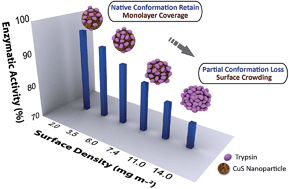Correlating enzyme density, conformation and activity on nanoparticle surfaces in highly functional bio-nanocomposites†
Abstract
The biological activity of the immobilized enzyme is crucial for the performance of different nanoparticle mediated enzymatic assays, where enzymatic conversion can be used for label-free analyte detection. In this article we have addressed two significant aspects of enzyme–nanoparticle interactions. First, we have developed copper sulfide (CuS) nanoparticles with an average diameter of 25 nm as a potential enzyme-interface using trypsin protease as a model enzyme. CuS nanoparticles showed high trypsin immobilization capacity of about 14.0 mg m−2 with the significant retention of native enzymatic activity (75–98%) at room temperature, even beyond the calculated tightly packed monolayer coverage (which is around 4.1 mg m−2). Second, we report a quantitative correlation between the structure–functional relationship and the density of immobilized trypsin on a nanoparticle surface. The in situ conformation of immobilized trypsin could be efficiently analyzed by fluorescence, circular dichroism and FT-IR spectroscopic measurements because of the small size of the nanoparticles. Trypsin molecules appear to retain their close-native tertiary and secondary structural features (with a small loss of 1–2% of helical content) in the entire surface density range (2.0–14.0 mg m−2) on the CuS nanoparticles. However, interestingly, at a low surface coverage (2.0 mg m−2), immobilized trypsin retains almost 98% of its native enzymatic activity, leading to a highly functional bio-nanocomposite. However, at higher surface coverages, the enzyme activity decreases to 77%, indicating the influence of steric crowding. Furthermore, the high functionality of the immobilized trypsin at low surface density on CuS nanoparticle was also confirmed by determining the kinetic parameters of enzymatic activity.


 Please wait while we load your content...
Please wait while we load your content...